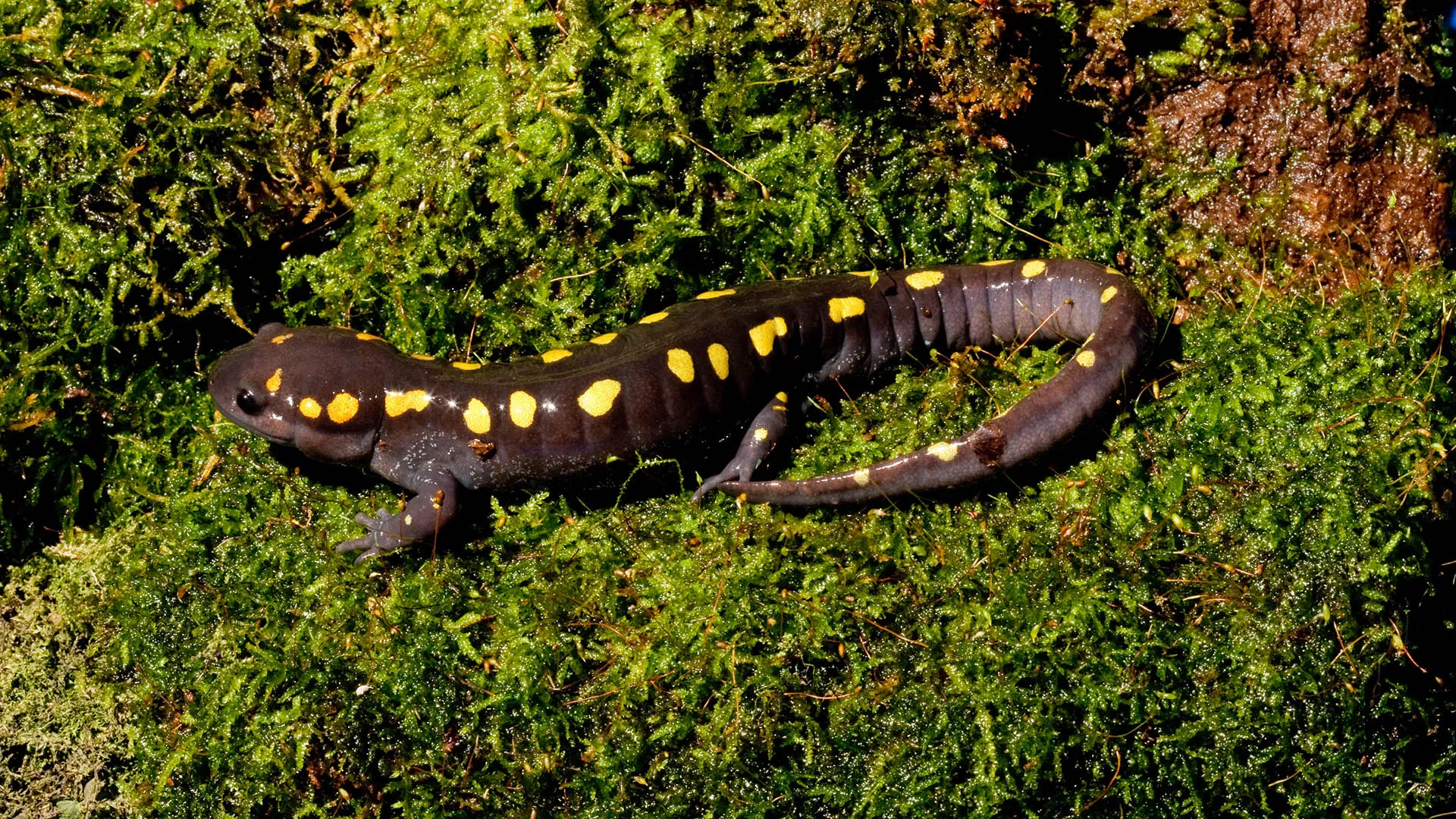During the year’s wettest months, small, temporary pools of water collect in low-lying areas among the hills, mountains and valleys of the Southeast. Known as “vernal pools” — in reference to their appearance in late winter and early spring — these ephemeral wetlands are a seemingly unimportant feature in our otherwise remarkable landscape.
To some, they may look like little more than puddles, but this belies the complex ecosystems they represent. In fact, vernal pools serve as nurseries for some of the region’s most strikingly beautiful wildlife, including many of the region’s salamanders, which rely on them for survival and reproduction.
Salamanders lay their eggs in water, where their young hatch as fully aquatic larvae. At this earliest life stage, they breathe using external gills, much like a fish, and dine on aquatic insects as they grow.
While some salamander species lay their eggs in flowing streams or permanent lakes and ponds, others — like the Spotted Salamander — have adopted a strategy that helps keep their offspring safe from the predators usually found in permanent bodies of water.
These salamanders lay their eggs in vernal pools, which develop after seasonal rains or snowmelt during the fall, winter and early spring. Existing for only a few months each year, they completely dry out during the summer, but this natural time limit makes them the perfect place for salamanders to lay their eggs.


“Their temporary nature is actually really important for the animals that use them,” says Jocelyn Stalker, a spatial ecologist and salamander expert at the Tennessee Aquarium Conservation Institute. “Because they are temporary, fish can’t live in them, so any organism laying its eggs in there is going to ensure that those eggs are safe from fish predators.”
Species like Spotted Salamanders are obligate users of vernal pools, which means they cannot reproduce in a permanent wetland or stream and must lay their eggs in these temporary bodies of water. Some other species take advantage of the safety of vernal pools for their young but also reproduce in other aquatic environments.
By the time the summer arrives and the pools dry up, the young salamanders have matured into their adult form and begin their life on dry land.
“They spread throughout the forest, they go find their food, and they live their happy little lives until it’s fall of the next year,” Stalker says.
Then, amazingly, these salamanders make the long trek back to the very same pool where they were born to reproduce and begin the cycle again. Because the landscape changes slowly, if at all, vernal pools tend to reappear in the same locations, year after year. As a result, some vernal pools have served as a breeding ground for generations of salamanders.
Some property owners dismiss vernal pools as an unsightly nuisance, but that stagnant body of water that fills up every December could be home to a lot more life than it seems at first glance if you know where — and when — to look.
Salamanders can be elusive. They are nocturnal, moving only at night and using objects like fallen leaves, rotting wood, bark and rocks as cover and protection from predators.
“The best time to see them is when they are out making those breeding migrations,” Stalker says.
Depending on the salamander species, migrations could be as early as October or as late as January and February and are triggered by a sudden rise in temperature and heavy rains.
“If you can get out on a rainy night right when it has suddenly gotten warmer, that’s the best chance at seeing them,” Stalker recommends.
If you’re not sure whether a temporary wetland on your property is a vernal pool, you can try checking it out on a warm, rainy night with a headlamp and flashlight to see what you find. Once the salamanders have arrived, they will remain in and around the pool for a short time as they lay their eggs, which offers wildlife enthusiasts a good chance of spotting them.
If you do discover a vernal pool, the best thing you can do is to simply leave it be. Since they often seem like little more than puddles, many people don’t realize they serve as important habitats. In some cases, property owners will fill in pools or deepen them to turn them into a pond stocked with fish. Once that happens, these here-and-gone wetlands can no longer serve as a haven for salamander eggs and their offspring.
Safeguarding salamanders is important to keep the ecosystem in balance, especially as their native habitat disappears. Salamanders play a vital role in the food chain, serving as both a predator of insects and prey for other, larger species. Thanks to their aquatic and terrestrial life stages, they also help move nutrients back and forth between both habitats.
The mystery of what lies just beneath the water’s surface in these fleeting pools of water is also part of their allure.
“Salamanders are unique,” Stalker says. “They’re really bright, and it’s just really cool to think that something so beautiful is hidden under a rock.
“There’s a sense of mystery and discovery associated with salamanders, and that’s a real pleasure.”
